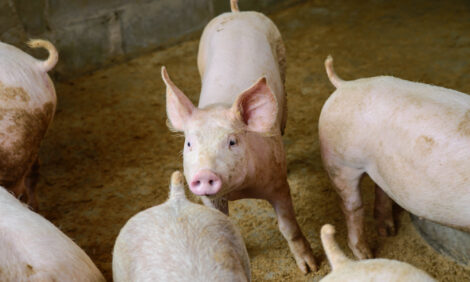



Overview of This Week’s Pig Industry News
ANALYSIS – With one of its partners deciding against further funding, the future of the University of Guelph‘s Enviropig is now in doubt, writes senior editor, Jackie Linden. Unlike their ‘natural’ cousins, the genetically modified pigs developed at Guelph are able to digest and absorb phosphorus from plant sources, which means the Enviropigs do not require supplementary phosphorus and they excrete less of the nutrient where it can cause environmental problems. In the US, high feed prices are said to be holding back herd expansion and North American producers have been warned to keep close control of production costs. Researchers have found evidence of banned antibiotics in feather meal, which is used as a feed ingredient.Since the 1990s, in an effort to reduce concerns about harm to the environment, Canada's University of Guelph has developed pigs that excrete lower levels of phosphorus. Excessive amounts of the nutrient cause algae blooms in water courses, threatening aquatic life.
At its latest general meeting, Ontario Pork decided to end Enviropig research funding after more than a decade.
Guelph University is continuing to seek a commercial partner for the project.
The announcement has been welcomed by organisations that oppose genetic modification.
US pork producers are holding back on expansion, even though the industry returned to profitability in the spring of 2011. However, higher feed prices in the past few months as a result of crop damage in South America has increased costs and reduced the profit outlook for 2012, according to Chris Hurt, Extension Economist at Purdue University.
Producers have not expanded in response to the profits they experienced over the past year for a number of reasons, including large financial losses in 2008 and 2009 and uncertainty over feed prices.
Dr Hurt added that the US pork industry’s costs structure has changed significantly from around $40 during the $2.00 a bushel corn era to closer to $60 per live hundredweight now.
A US-based agricultural economist is advising North American pork producers to keep a close watch on production costs.
Professor Ron Plain of the University of Missouri says one of the amazing things is just how volatile cost of production has become. He said that a decade ago, corn (maize) prices in the US were around two dollars per bushel, while it has been above six dollars now.
He said: “There's a lot more feed price risk than we used to have in the hog business so producers on both sides of the border need to pay a lot of attention to that.“
Also in the US, researchers have found evidence of banned antibiotics in feather meal, which is used in pig feed.
In a joint study, researchers at the Johns Hopkins Bloomberg School of Public Health and Arizona State University found evidence suggesting that a class of antibiotics previously banned by the US government for poultry production is still in use.
The study, conducted by the Bloomberg School‘s Center for a Livable Future and Arizona State’s Biodesign Institute, looked for drugs and other residues in feather meal, a common ingredient in chicken, swine, cattle and fish feed. The most important drugs found in the study were fluoroquinolones – broad-spectrum antibiotics used to treat serious bacterial infections in people, particularly those infections that have become resistant to older antibiotic classes. The banned drugs were found in eight of 12 samples of feather meal in a multi-state study. The findings were a surprise to scientists because fluoroquinolone use in US poultry production was banned by the US Food and Drug Administration in 2005.
This is the first time investigators have examined feather meal, a byproduct of poultry production made from poultry feathers, to determine what drugs poultry may have received prior to their slaughter and sale.
“The discovery of certain antibiotics in feather meal strongly suggests the continued use of these drugs, despite the ban put in place in 2005 by the FDA,“ said Dr David Love, lead author of the report. “The public health community has long been frustrated with the unwillingness of FDA to effectively address what antibiotics are fed to food animals.“
The US Poultry & Egg Association has released a statement to the report, which said: ‘The US commercial poultry industry does not use fluoroquinolones and has not since they were banned in 2005 by the FDA for poultry. In fact, ciprofloxacin, norfloxacin and ofloxacin found in this study – albeit at extremely low levels – have never been used in the US poultry industry. The fact that they are evident in this study calls into question the source of the feather meal that was tested, potential cross-contamination with other products, and ultimately the scientific objectivity of the research since it implies continued use of fluoroquinolones that were never used by the poultry industry in the first place.“
And finally, turning to pig diseases, emergency measures have been introduced in the Tver region in the west of the Russian Federation to control the spread of African swine fever (ASF). Tver is a region famed for its hunting grounds.








